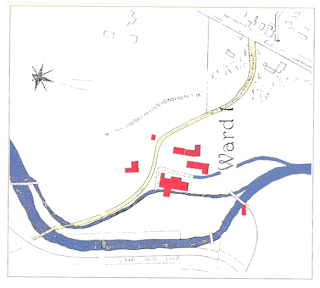 |
| "Taylor Bros. Mill on the Don River" by D.C. Grouse, 1810 |
From a single
water-powered lumber mill operating on the Don River in 1795, Todmorden grew through
the 1840s into a busy mill and brewery complex. Until steam power arrived after 1850, Todmorden relied on water power supplied through a
system of mill races and water wheels.
A mill race is a manmade channel that diverts
part of a river's flow into the water wheel of a mill. The head race carries water to the wheel, and the tail race returns
the water to the river, carrying away waste products from the mill. Mechanical sluice gates control the level of the
water in the mill race.
 |
| A mill pond would form above the dam, storing water power. |
Todmorden’s Two Mill Races
 |
| Todmorden's head race split in two north of the paper mill, 1876 |
The west race remained as an uncovered watercourse, running between the paper mill building and what is now the Don Valley Parkway.
 |
| Todmorden, 1910. The underground east race is marked as a dotted line. The west race runs from the dam, along Pottery Road. |
Fire destroyed some of Todmorden’s industry in 1847. As steam power became available, the need for water power declined, and Todmorden’s mill races were ultimately used as drains for steam-powered mills.
Todmorden’s West Mill Race
In 2004, archaeologists uncovered a portion of the wheel house and west race with its preserved wooden sluice gate still in place.
Todmorden's East Mill Race
 Todmorden’s
mill races were gradually filled in by debris from both the Brick Works and excavation debris from construction projects in the booming city of Toronto. Todmorden’s underground
east mill race remains intact beneath several metres of landfill, and a portion of
its 4-metre-wide arched roof was discovered by archeologists during excavations around the paper mill building in 2000.
Todmorden’s
mill races were gradually filled in by debris from both the Brick Works and excavation debris from construction projects in the booming city of Toronto. Todmorden’s underground
east mill race remains intact beneath several metres of landfill, and a portion of
its 4-metre-wide arched roof was discovered by archeologists during excavations around the paper mill building in 2000.The underground east race resurfaced at a spot near the brewery and ran along the east bank of the Don River until it emptied into the south bend of the oxbow. One of Todmorden’s tail races is still visible near the entrance to the Wildflower Preserve, a partially filled ditch running to the west of the path.
A mill race is a powerful and sometimes dangerous watercourse. One of William Helliwell’s children died in an accident at the mill in 1844, possibly drowning in the millrace.
Steam power came to Todmorden in the 1870s, and the paper mill's landmark chimney was built. Water power became a secondary, back-up system to coal-fired steam engines. As power generation changed, Todmorden’s mill races continued to in use, but mostly as sewers for factory wastes. Chemical effluent from paper mills and organic wastes from saw mills damaged the water quality of the Don River.
In 1917, Todmorden was acquired by a Toronto construction company and used as a landfill for excavation debris from downtown building sites. The first storeys of the
paper mill building and the brewery, as well as Todmorden's mill races, were buried under several metres of landfill.



No comments:
Post a Comment
All posts are moderated.